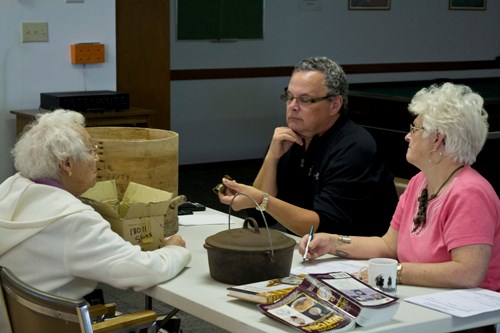Hiding away or displayed prominently there are items found in homes, at garage sales, or in auctions that are discovered to be a lost treasure.
Though these little treasures vary between heirlooms or simply a discovery in a box of odds and ends, they all have something in common. They are all antiques and someone, somewhere will find something that means everything to them.
On Sunday, Sept. 29, from 10 a.m. to 4 p.m. the Wawota and District Museum welcomed Terry Smith, an appraiser, from Brandon to evaluate heirlooms and antiques at the Drop In Centre.
Smith first began learning about antiques, collecting, and appraising items approximately 30 years ago.
"I love to identify things!" Smith exclaimed. "To figure out the why, what, where, and when."
Smith explained that his first encounter with, what would soon be, his passion for collecting developed through his wife's interest in painting white ware.
"After I got married I liked the white ware that my wife was doing, she was painting white ware, and then I started investigating and found, 'hey, this is porcelain,' and I learned the history of porcelain," Smith stated. "And it took off from there."
Personally Smith looks for porcelain figures as the centre piece to his collection and feels that older is truly better.
"I like age, meaning the older the better or the older the style the better or the older the maker the better," Smith explained of his personal preference in collecting.
However, most of those who made the trek to Wawota to see Smith were not collectors, but simply people interested in an old heirloom handed down to them throughout the years.
People in the community were encouraged to bring their old books, china, paintings, chairs, and antiques to be appraised.
Taking into account the age of the item, its condition, and its known history, Smith would explain what something was used for, what time period it was from, and an approximate monetary value; however, many exclaimed that whether it was worth more or less than they thought that it wasn't something that would be for sale. Most of the attendees brought items which they were simply interested in the history of.
Smith found he was intrigued by a number of pieces while in Wawota including a watch, a small Russian cup, and a monkey perfume bottle.
"Little bits that seem unimportant, but have something to say, if you know how to read it, that's where I kick in," Smith said. "I enjoy that kind of thing."
Though intrigued by items Smith went on to explain to The Observer that these appraisals are to the benefit of the person bringing the item in and that if an appraiser ever offers to buy something it should raise a red flag as the appraiser may be taking advantage of the individual who attends.
"I have seen many, many, many, many pieces over the years and I have never purchased, it's unethical," Smith stated. "When you have somebody appraising or going to an appraisal session and their goal is to purchase, how can you trust them? How can you tell somebody that this is worth this, but I'll give you this money right now for it? It's unethical."
The positive experience at the Drop In Centre, though, had many excited to have found out even just a little bit more about their treasures and heirlooms that they were unaware of before seeing Smith.
Overall more than 24 individuals from the area brought in, on average, three items each and Smith spent his time appraising and explaining the histories of over 100 items.




